SEC S18-W3 || Psychology and Market Cycle
Hello all my friends...
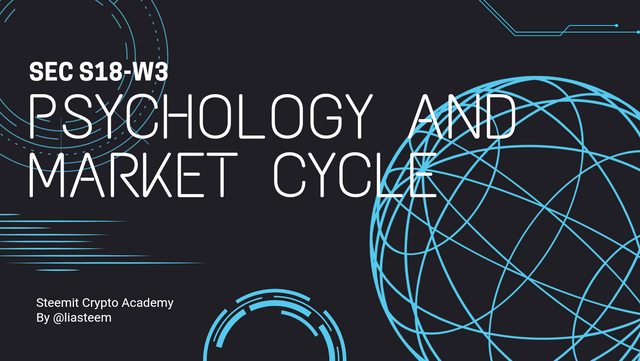
This time the theme is very interesting, namely about Psychology and Market Cycle. This is Season 18 and week three of the Steemit Engagement Challenge. We need to know this because it can influence the influence of our power on the ecosystem and the way we trade so that we don't become victims of our own emotions which can lead to destruction. Below are some of the questions asked and I will try to outline them as best as I can.

Describe the psychological progression of investors through the stages of optimism, excitement, euphoria, anxiety, denial, fear, despair and hope. How does each step influence investor behavior?
We must know that the price of an asset is partly determined by the reaction between buyers and sellers of the asset in the market, so this influences the general perception of market participants. In fact, we have to know that in asset trading (trading) there is something called trading psychology which describes and shows the opinions of individual investors, while the second is market psychology which describes and shows the collective opinions of investors (both their thoughts, emotions, sentiments and reactions on the market) This is indeed very similar but very different.
Investors who have basic knowledge of market movements have a clear mental picture of the current market cycle, this provides opportunities for seasonal investments based on observed facts and logic. On the other hand, investors who lack knowledge about market movements utilize their human mechanisms which are driven by emotions, and general assumptions to make investment decisions, this results in incorrect analysis of market movements, emotional suffering and loss of capital and not making profits until become frustrated.
In market psychology, cycles give investors and traders a different perspective on what is happening and they will generate sound reasoning. Market cycle psychology assumes that traders' emotions are different when facing an uptrend and a downtrend.
During Uptrend;
- during an uptrend investors' emotions are usually very good and more positive, and they believe that there will be a market revival and the bullish phase will continue
During Downtrend;
- When a downtrend occurs, investors will usually experience soaring emotions, and all current decisions are truly irrational because when the downtrend forms a bearish phase, fear, panic, despair and frustration will dominate.

Using a chart showing a recent movement in the price of a cryptocurrency (without date/time), identify which emotional stage of the market cycle the chart likely represents. Justify your answer by discussing behavioral signs that investors might exhibit at this stage.
Well, let's look at the graph below which shows the emotional stages of the market cycle by investors;
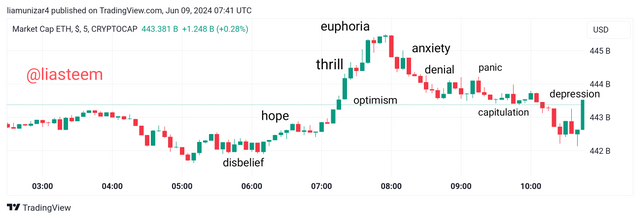
Image source
The screenshot above shows how market movements really influence investors, even though it is investors who inject assets into trading, thereby influencing the direction of the trend. In the chart above we can see where investors' emotions are clearly played out.
In the disbelief phase, investors just want this phase to end because they think "I'm going to fail" and the trend will change soon. Then the trend increases, making investors' emotions change to Hope which will raise the question in investors "is it possible that this trend will increase further?". Then the trend rose again until investors who were previously in the disbelief and hope buying phase became "everyone buy now". And the trend continues to rise until investors become very happy and feel that I will get richer so that when the trend goes down ("Complacency") Investors become a little nervous, they still have their egos hanging on "let's coast for a minute".
Even though it wasn't over yet, investors experienced emotional turmoil again until the "deniel" phase and said "I'm freaking out" but there was still hope in their hearts. And then it goes to the "Panic" phase where investors feel that "I'm trapped". And finally, when there is no significant trend movement, that's when the investor realizes that he has analyzed the trend wrong and gives upuntil the uncontrollable emotion is "Oh My God, No No No"... Which makes him "frustrated" and ends up losing money to the point of going bankrupt and even committing suicide.
This is where we need to understand the current market movement cycle. Not only do you hope for quick wealth, but you also have to be alert and not be taken in by emotions that change for no reason, and you should study the direction of trends better to prevent us from analyzing market trends.

Discuss how an incorrect mindset, such as the belief that "this time it's different," can affect an investor's decisions and potential returns. How does this mentality typically affect a person's performance in the market during volatile phases?
"this time it's different," is actually investors' emotions long before seeing the upward trend movement. In the phase of waiting for an upward trend and hoping that something good will happen, because they are too tired of waiting, finally the slightest upward trend movement, investors immediately seize the opportunity.
But in fact, investors forget that "anything can happen in the next second". They forget and become blind to the signs that will reverse the market trend. They even dare to double their investment and hope to become richer. In fact, this usually happens among new investors in the cryptocurrency sector, most of whom invest because the price of crypto assets continues to increase, while experienced investors are also affected when they rely on human mechanisms (emotions) to invest.
Those who are trapped in the "this time it's different" phase will definitely experience many undesirable things. Once again because they think that this is when the bullish cycle occurs and the trend will definitely continue to rise because maybe this time it will be different. In fact, this is the beginning of the bearish phase which indicates the trend will return down.
At that time, we still thought that by injecting more assets, the trend would immediately rise again, but experienced investors would stop it during that phase, leaving investors without much experience and making them consumed by emotions and finally, when the trend reversed, At that moment the investor was shocked and realized that he was a victim of market psychology. Invested assets cannot be withdrawn. And now the words "this time it's different," have taken their toll.

Examine a specific incident where significantly FOMO (fear of missing out) or FUD (fear, uncertainty, and doubt) impacted the price of the STEEM token. Discuss how this sentiment influences trading behaviors and the price of the STEEM token. Also suggest strategies that STEEM investors could use to avoid making decisions driven by these emotions.
Fear of Missing Out (FOMO)
Fear of missing out is a mental state triggered by fear and experienced by traders when they do not participate in a long-standing bull market rally. This mental condition is triggered by thinking about what other participants are doing, namely investors are busy thinking about the profits obtained by other investors from rising prices during yesterday's bull market rally. This is a late participation in yesterday's rising trend, so that when asset prices are high and a price increase is imminent, investors with FOMO invest.
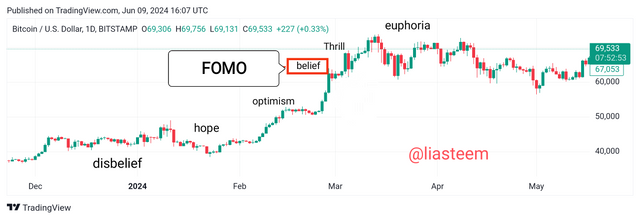
Image source
Successful FOMO makes investors invest in the wrong market cycle, while experienced investors realize and immediately secure profits (close long positions) around that area, thereby causing a decline in asset prices. These areas are referred to as hype zones in market psychology circles (new investors inject assets, while experienced investors do the opposite).
Fear, uncertainty, and doubt(/h3)
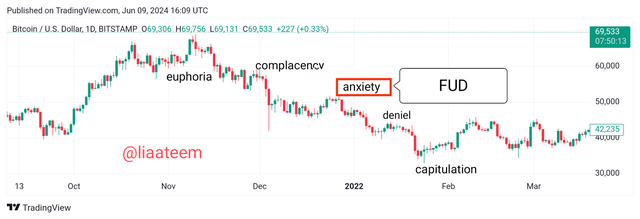
Image source
Fear, uncertainty, and doubt originate from human emotions that arise when investments made move in a bearish trend. This emotional state is triggered by the fear of losing more money. When Investors experience FUD, they react by closing their trading positions towards the end of the bearish trend, where mana Asset prices are generally assumed to be cheaper and discounted. even though the end of a bearish trend can be said to be the beginning of a bullish trend. This is represented as the panic zone in market psychology cycles.
These two things (FOMO and FUD) are both detrimental and emotionally consuming for investors without them realizing it. Even in Steem assets, we often see this where when the price of Steem rises, those with FOMO will feel jealous and why don't they try it, maybe the price of Steem will also be higher like those who get these benefits. Finally, they bought and it turned out that the trend reversed because of the delay in investing.
Likewise with those who are FUD, they are afraid that the price of Steem will fall so they will sell their Steem assets even though at that time the price is cheap. In 2022, many people sold their steem because of rumors spread (steem will close) by those who are irresponsible.
So, there are several strategies that STEEM investors could use to avoid making decisions driven by these emotions;
- Don't be too overconfident! It's better to enter with a 1:2 profit if it will burden your mind later.
- Try to invest time analyzing market rumors, before making any trading transactions.
- If you are not sure then don't participate or postpone it.
- Don't panic when you see prices fluctuating, or you can see how the market cycle affects investors
- Always try to be optimistic and win at least 3 times or try to get the first impression that you can win so that on the second chance that feeling will help you.
- Don't be greedy, close when the position matches the initial target.
- condition yourself physically and mentally in a calm, comfortable and good condition.
The point is that you must really develop trading strategies and rules that confirm investment opportunities in the early stages of the market cycle (optimism and Confidence) and form a disciplined habit of following the rules established in the world of trading. Remember that we are humans who have emotions and thoughts.

Explain the logic behind the “buy red and sell green” strategy. Create a hypothetical scenario in which this strategy could be applied effectively and discuss the psychological challenges an investor might face when trying to implement this strategy amid an actual market downturn and subsequent recovery.
The logic in the "buy red and sell green" strategy is the two colors on the candlestick that are commonly used. Red means there is a decline in share prices (bearish), which means the closing price is lower than the opening price, so when this happens we are proposed to buy. On the other hand, green means there is an increase in stock prices (bullish), which means the closing price is higher than the opening price, so we are proposed to sell so that when these two colors appear, we can make a profit.
However, there are times when investors are in the red zone, emotions arise which will influence stock purchases. Maybe it's the fear that the shares will turn up so that they feel anxious and ultimately disappointed until they are afraid of losing and finally the investor decides to just pass it up so that a good opportunity is simply missed.
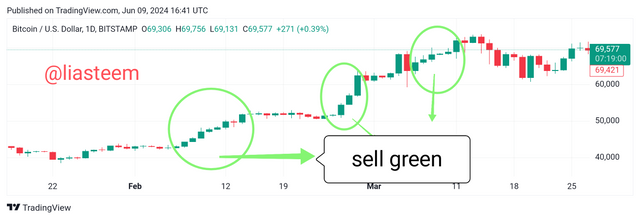
And when the investor is in the green zone, emotions flare up again and he is too confident that he can get higher profits and can become very rich so he delays selling until the green zone stops and turns into the red zone, then he has missed his golden opportunity in get multiple profits.
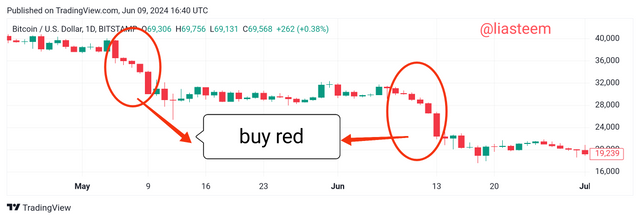
If investors are already in the investment stage, then when the price moves in the same direction as the position (green zone), trading emotions make beginners worry that the price will reverse direction, so they rush to close the trading position to liquidate profits. On the other hand, when the price moves against the position (red zone), novice traders who are too worried will immediately close the position because they are afraid that their losses will increase. In fact, the price could only move in a correction and return to the direction that corresponds to the trading position not long after.
Emotions in trading have a big influence on investor decisions. Therefore, we must really know how and when market cycles occur without ignoring discipline and basic rules in trading. As a human being, want mGetting more profits is normal, but you still have to be calm and don't make mistakes when analyzing market movements. As they say Trading is 1% Intelligence, 99% Emotional Trading Management.

Until here, my participation in the Steemit Engagement Challenge S18W3 at SteemitCryptoAcademy.
I would like to invite my friends to participate in this Steemit Engagement Challenge, @drhira @irawandedy @goodybest @paholags @nancy0 @starrchris @sahmie @hamzayousafzai
greetings,
From your friend
❤
Upvoted. Thank You for sending some of your rewards to @null. It will make Steem stronger.
You are welcome 👍
Emotions can really mess with our trading decisions, especially when we see those red and green candlesticks. When we're in the red zone, fear can make us miss good chances by holding onto losing stocks for too long. And when we're in the green zone, overconfidence can make us wait too long to sell and miss out on big profits. It's crucial to understand market cycles, stick to trading rules, and keep emotions in check to make wise decisions. Trading is all about staying calm and making smart moves.
You are right brother, thanks for stopping by on my post, I really appreciate it...
Putting oil trust on your emotions while trading is very risky and most totals advised their students to strengthen their emotional decision-making skill so that their psychological emotions won't turn out to be
You are right my friend, thanks for your comments...
👍
I like this word. In financial market there are different types of investors, so they have to wait for their season in the market.
Basic knowledge on financial market is must needed. You explained nicely about market and investors psychology. 👍🏼
Usually beginners are very hopeful when investors start investing in their shares, because this will be a big opportunity for beginners to make a profit, even though it is small, it really affects the emotions of beginners, but it still has to be based on good emotions,
Thank you for your visit, I really appreciate it,
👍
Being emotional in all actions is not good, especially in the world of trading which involves investment. Everything has rules and discipline that we must follow. Increasing knowledge before investing can also bind our emotions when the trend is rising, wherever we are, we must be calm and in a good emotional state in order to get good results too. Hard work and discipline always produce real results.
I see you have achieved a lot of progress in the world of trading. Congratulations....
We wish you success with your presentation
Thanks for your support, ❤
Your post has been successfully curated by our team via @steemdoctor1 at 35%.
Thank you for your committed efforts, we urge you to do more and keep posting high-quality content for a chance to earn valuable upvotes from our team of curators and why not be selected for an additional upvote later this week in our top selection.
Thanks for your support @steemdoctor1... 🙏